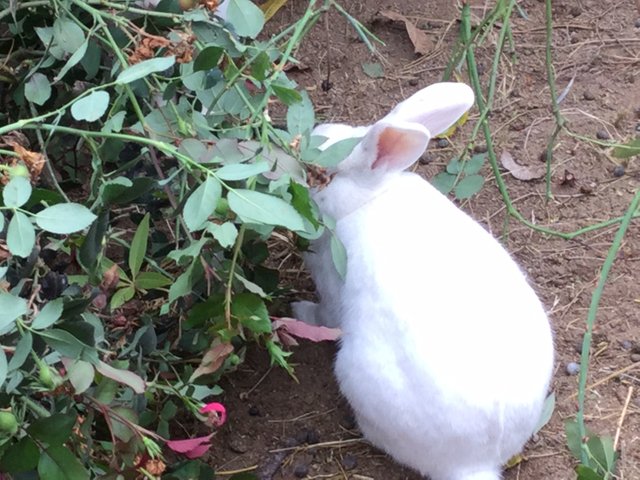PermaCulture Series: Residential Yards
Meat Rabbits in the Yard

Over my two year experiment raising rabbits in a permaculture mindset and within a normal sized suburban yard, I have learned quite a bit about how the animals effect the yard and a few tricks that help them earn their keep around the home.
Converting rabbit waste into fertile garden soil is one of the more obvious and useful functions they serve. Something less obvious, but just as useful is their appetite for rose bushes. With the pruned branches flipped upside down to help them avoid thorns, the rabbits will remove a substantial percentage of green matter over a 12 hour period. The remaining branches are much easier to work with and it takes a few minutes per bush to get the woody material into the green waste bin. I'll be saving some of the larger woody pieces to experiment with some smoking some meats as well.
Sago plants work well for holding the roses in this position so the rabbits can eat all of the leaves and strip the bark off of the stems, but anyway you can get them to lay upside down will work. Rose bushes make up a substantial portion of my rabbits diet for several weeks out of the year as I prune them. I'd guess my rabbits make the rose leaves and tiny branches over 50% of their daily diet for 2-3 days/large bush ((5) 8 week olds & 3 adults).
So I do some quick pruning and my rabbits get dinner. In return for their food, the rabbits remove a large percentage of matter from the branches. The next day I can come through and it makes cleaning up much easier while also taking up less space in the bin. Alternatively, the branches can also go down with the waste wood I'm burying in this years semi-hugulkultur garden bed. Either way, there is less waste produced from the yard as the previous years growth from a plant inedible to me is recycled back into the soil through the rabbit droppings, or transferred up the food chain in the meat.
The following plant species that are what I've found the rabbits to enjoy eating enough to be used in this way;
- Queen Palms
- Apples
- Rose Bushes
- Pyrocanthous (I've seen it listed in Poisnous for Rabbit Lists, so I typically keep portions smaller)
I routinely use Queen Palm's giant, fan like leaves in lieu of Hay for up to a week at a time. The rabbits will still choose the queen palms over any hay I've tried except Alfalfa given free choice after that so they must like it. These leaves provide the high fiber bulk vegetable matter for the bunnies while also giving them something to wear their ever growing teeth on. I've also noticed the rabbits seem far more content when they have something fresh to eat on a regular basis. And for the those who want some more precise information, I did look up some studies from a Caribbean Island college that documented meat rabbit performance when palm leaves were used in varying ratios. The studies were very detailed and could provide some useful information to anyone raising rabbits on a more Business type scenario where the profit ratio/rabbit is important.
Some observations I've made while letting some of the rabbits free-range in the back yard;
- Even given a wide range of plants to eat, rabbits spend at least half of the time eating regular grass on a daily basis
- Bark from apples, roses, Crepe Myrtle, & other bushes are routinley eaten as well
- Males and growing juveniles are able to sustain themselves wholly on yard vegetation. Males remain fertile in my situation.
- Adding a small amount (~15% of calories) of alfalfa or pellets to the foraged feed is enough to grow out a litter in 12 weeks for eating
- A littler of growing rabbits and 1-2 adults can keep a regular sized lawn effectively 'mowed'
- The addition of rabbits has improved overall grass health in the yard noticeably
- Only the apple tree was stripped of bark to the point where it impacted tree health & growth
- Rabbits quickly establish a hierarchy when allowed to socialize. My alpha male spends a good amount of time in what appears to be yard patrols. Interesting to see instincts like that come out within weeks of being let out of a cage for the first time in what is most likely many many generations.
do you have any difficulty with predators? Feral/outside cats or such critters as coyotes or other local carnivore?
I've had problems with dogs (My own dogs when I tried keeping the rabbits in a smaller fenced off portion of the yard). The baby rabbits are kept safe in a make-shift 'cave' I connected to the cages. This also lets the confined rabbits have access to a sheltered spot in the heat of summer which is my most difficult natural element to deal with living in the desert. I'll put together another post that details this further as it solves one of the major problems with raising rabbits in hot climates.
There are some hawks in the area that could pose an issue, but I've not had any issues with cats, possums, or raccoons up to this point. In my experience, any time one lets rabbits have access to some more natural habitat, they run the risk of losing some rabbits to predators. There's not much that can be done about this without going through some significant expenses.
Upvoted by @gardening-trail
Thank you for following and upvoting @gardening-trail
Read our guidelines here
We are starting some meat rabbits ourselves, and learning the ropes.
I've done a few updates with our first batch of bunnies!!!
I saw that, good luck with your first run at it. I'll be looking for future updates!
Update coming soon...